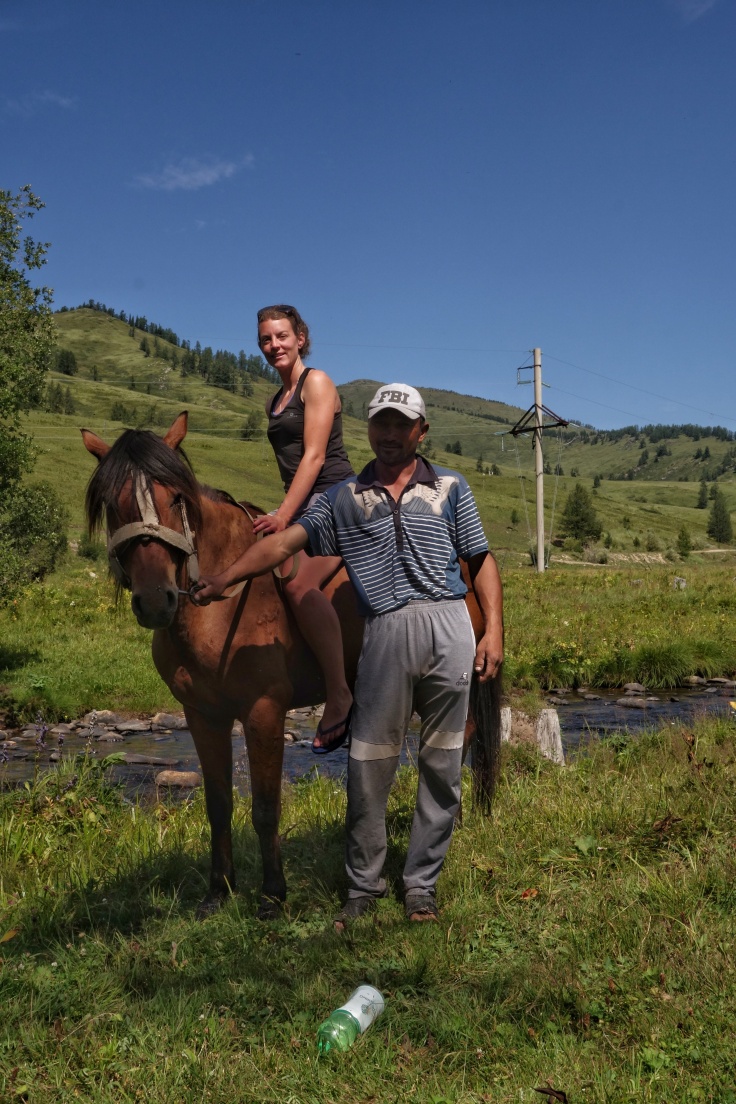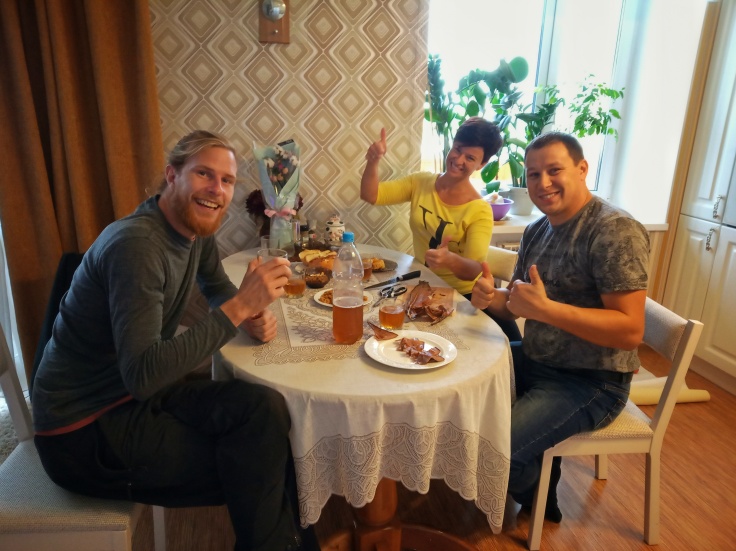We had highly anticipated our return to the Russian Altai. Not only were we re-entering a land where the food options were more than just boiled mutton, we were heading back into one of our favourite regions, with plans to explore some enduro trails in the remote mountains. Immediately after we entered we noticed a change in the people. We were given free apples, a local man welded Ryan’s broken gear shifter for free and a kind lady chased after us with our tablet computer we had mindlessly left in the cafe.
The only bad thing about the Altai region (aside from unpredictable weather) is the need for permits to explore its more remote areas. The unique position of the mountain range at the crossroads of Russia,China, Mongolia and Kazakhstan means it a sensitive region, and not one the authorities want wandering tourists to get lost in. Mount Belukha is the epicenter of this region, with many Buddhists and Pagans believeing it to be the site of Shambala (shangri-la). We hadn’t managed to secure a permit for the region, but decided exploring was worth the risk of a fine. We turned off the main road to follow the mighty Katan river towards mount Belukha. The 4×4 track took us through beautiful villages nestling in the river valley where the water crashed through, a glacial blue.


We met three young guys on enduro bikes heading the opposite way, they assured us we would have no trouble on the track, which quickly turned into a single lane horse trail. As the evening drew in, we reached a sharp, rocky descent to the river side. Ryan plunged down the first section with Lottie timidly following on the sharp boulders and loose gravel that covered the steep narrow track. Confused as to how on earth the guys had got their bikes up the way we were going, we got off the bikes in the hope of walking them down further. After about 200m of difficult descent we reached an impassable section. The track was way too tough for us. Deciding to turn around, we managed to push Lottie’s bike to a relatively flat ledge, start it up and blast up the trail, bouncing around wildly. However, Ryan’s bike was not only wedged on a rocky outcrop facing the wrong way, it would not start. Sweating under the scorching sun (that had made a rare appearance) we drained the carb, stripped the bike of luggage and attempted to push the bike up the bouldery track. We managed about 5m before we had to stop, out of breath and knackered.

The going was impossible. We were therefore unusually grateful to be joined by a drunk man on a horse picking his way up the track behind us. After a ten minute incomprehensible conversation, he chucked Ryan a rope to tie around his bike. Then with Ryan fighting to keep the bike upright (and therefore getting the best work out of our travels), the horse pulled the bike up the hill. Once at the top, mandatory vodka was consumed alongside smoked cheese and apple juice. Our saviour forced Lottie to take a ride on the horse, the poor thing was probably exhausted enough, and we enjoyed the company of the local guys who thought we were completely mad and pointed us in the direction of the easier, correct track to descend to the valley floor.

This was one of our many failed escapades on enduro tracks in the Rusian Altai. Despite our best efforts, the weather, our ability and the fact our bikes are laden with luggage, stopped us from completing any of the tracks we set out to.
However 173km as the crow flies we were much more sucessful. In the Kazakh Altai we managed to sweet talk the check point guards into entering the restricted area without a permit, and set out in the sunshine on the Southern side of Belukha to discver what the Kazakh Altai had to offer. Our first stop was Beryl where we had heard there was an ancient Scythian burial mound. On our way to the mounds two shepherds raced their horses alongside our bikes flagging us down on the small gravel road. They were insistent we drank tea with them in their yurt. In our previous trips to Kazakhstan we had not seen a single yurt, and believed the Soviets had destroyed all nomadic culture as they forced Kazakh nomads into collective farms in the 1930s. However, in a small field, a yurt, taller than the Mongolian ger, and and much more sparsely decorated, stood under the cover of a large tree.
The shepherds could not believe the detour we had to take to get to them from Kosh Agach (Russian Altai on the border with Mongolia). They explained a route through the hills that would take us there in a matter of days and only a few hundered kilometers. For these people, the artificial borders set by politicians in far away cities had no meaning. We went on to see many more yurts in the Altai region of Kazakhstan which is still home to traditional cultures and nomadic people; Kazakh, Mongol, Kalmyk and more who roam the hills searching for pasture for their animals, and preserving their ancient beliefs and rituals.


Like so many other ancient steppe peoples the Scythians had spread from the far reaches of Siberia to the Pamir mountains in Tajikistan. Around at the same time as the Ancient Greeks, traces of their presence have littered our journey across Asia, and the Altai was no exception. We had ventured to find a recent unearthing of Scythian history. Just past the shepherd’s yurt, the permafrost had melted to reveal a huge burial complex. At the heart lay the grave of what was thought to be a prince, buried alongside his horses in full regalia. What was amazing about the site, was due to the permafrost, the bodies and clothing of man and horse had been amazingly preserved. When we visited archeological students were working on one of the hundreds of burial mounds surrounding the prince.
Aside from our geeky interest in history, the other draw to this far East corner of Kazakhstan was the Austrian road. Ryan had found it on the website www.dangerousroads.org and had been determined we tackle it. The road got its name from Stalin’s prisoners of war, captured on the Eastern front, who endured extreme conditions to build a road traversing the border with China. Testament to their suffering is a fantastic road, that is still in decent condition that snakes through wildflower meadows, crisscrosses rivers on dodgy bridges before traversing the shores of lake Markakol high in the hills. Eventually the road descends through forestry and muddy tracks before spitting you out on the edge of the White Sand Desert which marks the Chinese border.
As usual Kazakhstan had even more to offer than we expected. Glorious camping spots alongside crystal clear rivers and reservoirs allowed us to enjoy the long summer days alongside locals who cooked us shashliq, played folk music and sent us on our way with honey, cucumbers and mushrooms.
This slideshow requires JavaScript.
We had been dreading our ride through the steppe to Astana. However, the three days from the riverside in Oskemen to the shiny new capital passed in a mesmerising vista of swaying grasses. It became clear to us why nomads call the steppe ‘a sea of grass’ as the winds, which became stronger and stronger created waves out of the pale green stalks. Astana sprouted suddenly out of the ocean, a gleaming capital, braced against the winds of the steppe.
Surprisingly we loved the strange, otherworldly city. The architecture was unusual, mostly designed by British architect Norman Foster. The heart of the city is dominated by a large white Baiterek tower topped with a golden egg. The statue symbolises the ancient story of Kazakhs, where an eagle defeats an evil dragon and lays a golden egg. We were particularly enthralled by the idea of being able to visit a beach miles from the sea, and headed to the Khan Shantir (a huge glass yurt housing a shopping centre, and the beach) to drink cocktails and watch the local wannabe porn stars pose with blow up swans. We are not sure it is exactly what President Nazerbaev had in mind when he moved the capital from Almaty in 1993, but we are sure he enjoys a blow up swan as much as the next Kazakh.
Torrential rain and strong winds kept us in Astana for over a week, and when we eventually got on the road northwest we found it had turned to a muddy mush due to the recent weather. On searching for a campsite after a long day Lottie caught a small slide on her rear wheel. Catching her foot in the grass her knee twisted and she cursed in pain. Initially she tried to walk it off, but it was clear the damage was serious. With over 100km to the nearest city we had no choice but to set up camp for the night where she had landed. Luckily we had attracted the attention of a caretaker, and Sergey came to see what all the fuss was about. He gave us water and helped to manoeuvre Lottie around the camp. In the morning he came to check we could get on the road ok, and with Ryan starting Lottie’s bike and loading her onto it, we set off tentatively along the slippy track.


We made it to the nearest city, Kostanay, where we checked into a hotel. Having a sore leg was an excellent excuse for Lottie to laze about and gorge on room service pizza. Ryan on the otherhand had no excuse, but enjoyed four days of bike servicing and lazing around nonetheless. On our final day, Ryan was preparing the bikes (in the pouring rain) when he noticed his rear wheel was severely wobbly. Thinking it was a rear bearing he headed to the local garage to use their space. It turned out the problem was not the bearing but the spokes on his wheel. Our spokes have been seized pretty much for the whole trip, which is a bit of an issue as you need to ensure you maintain tightness within the spokes to stop your wheel from buckling. Ryan’s spokes had worked their way loose, and with no way of tightening them or replacing them in Kostanay, we took the uncomfortable decision to tackle our ride across Russia on the dodgy, wobbly wheel.

At the garage Ryan also met the fabulous Lydia. A local English translator, she was over the moon to meet two native English speakers. Despite studying in Moscow and translating for a living she had never spoken to a stove English speaker! Lydia has boundless energy and alongside her husband Slava, took us on a tour of the sights of Kostanay. It was so lovely to spend the evening with Lydia and Slava who have two children. They told us that like many children in Kostanay and Northen Kazakhstan, they only speak Russian despite being born as second generation Kazakhs. Recently the Kazakh government has passed a law stating that lessons be taught in Kazakh, Russian and English. This means many children are suddenly at a disadvantage at school as they cannot speak Kazakh. This was an interesting perspective for us having met many young Kazakhs in Almaty who told us unless they speak Russian they are unlikely to get a job.

Loaded down with dried fish, pickled cucumbers, and tinned elk, Lydia and Slava sent us on our way to the Russian border the following day. On crossing the border into Russia we commenced our route west and the long road home. We crossed the Urals in a haze of sleepy eyed villages, tarmac roads broken up by little old ladies selling mushrooms and apples, and as the kilometers passed it was amazing to see how in touch with the land Russian people still are. We were surprised at the mingling of cultures as we passed mosques that looked like churches and Russian looking people greeted us with Kazakh language. The timber framed houses with blue painted windows which we had for so long associated with Kazakhstan, now lined the Russian roadsides and we reflected again on the borders which appear as lines on maps, but in reality don’t exist in a land so intermingled with ancient and new cultures.
This slideshow requires JavaScript.
Not many people would welcome us into their home after five days without a shower. But Yuri and Marina are something special.
 We wanted to make the most of our ten days in Russia, and so had planned a rest day in Samara, a city on the Volga river. Interestingly the city has played the capital of Russia on three occasions, and was Stalin’s hiding place during the Great Patriotic War (WWII). We wanted to meet local people and had contacted Yuri and Marina through Couchsurfing (a website where people offer their spare room/couch to travelers). Yuri had served as a Colonel in the Soviet army in Afghanistan and across the former USSR. His wife Marina was a Russian born in Tashkent, Uzbekistan which was a major city during the soviet era. In contrast to many of the people we had met they proudly told us of the good times under communist rule where you could guarantee food on the table and a good education. Yuri wore his ‘born in the USSR’ t-shirt just for us, and we learnt a lot about what good the Soviets did. Yuri and marina completely humbled us with their generosity. Despite living and traveling off a small pension, they have welcomed hundreds of travellers to their home. Proudly showing us his Decathlon sleeping mats, Yuri revealed they had saved for months to buy them. Earlier in the day we had considered popping into Decathlon to see what ‘cheap’ roll mats they had. With Yuri, Marina and two other guests, we feasted on Uzbek plov whilst drinking Russian beer and eating Kazakh honey, and couldn’t think of a better place to mingle all these cultures than the golden beachs of Samara.
We wanted to make the most of our ten days in Russia, and so had planned a rest day in Samara, a city on the Volga river. Interestingly the city has played the capital of Russia on three occasions, and was Stalin’s hiding place during the Great Patriotic War (WWII). We wanted to meet local people and had contacted Yuri and Marina through Couchsurfing (a website where people offer their spare room/couch to travelers). Yuri had served as a Colonel in the Soviet army in Afghanistan and across the former USSR. His wife Marina was a Russian born in Tashkent, Uzbekistan which was a major city during the soviet era. In contrast to many of the people we had met they proudly told us of the good times under communist rule where you could guarantee food on the table and a good education. Yuri wore his ‘born in the USSR’ t-shirt just for us, and we learnt a lot about what good the Soviets did. Yuri and marina completely humbled us with their generosity. Despite living and traveling off a small pension, they have welcomed hundreds of travellers to their home. Proudly showing us his Decathlon sleeping mats, Yuri revealed they had saved for months to buy them. Earlier in the day we had considered popping into Decathlon to see what ‘cheap’ roll mats they had. With Yuri, Marina and two other guests, we feasted on Uzbek plov whilst drinking Russian beer and eating Kazakh honey, and couldn’t think of a better place to mingle all these cultures than the golden beachs of Samara.
Crossing the Volga we entered continental Europe and four days of butt numbing riding brought us to the Ukrainian border. We had followed in Ghengis Khan’s footsteps from the Siberian forest, across the towering Altai, across the Eurasian steppe and were now knocking on the door of Europe. We had traversed a land with difficult political borders, which divide a people who exist in an amalgamation of cultures and history. In places they lament the Soviet era, in others they try to forget it and the horrors it perpetrated. On high plateaus people worship ancient pagan gods whereas on low farmlands they bend their knee in Orthodox churches. But whether they live in felt lined yurts, timber framed wonky houses or soviet era apartment blocks there are a number of continuums to the people that inhabit this region. Hospitality, humility and generosity. We were lucky to meet and learn about an amazing group of people who not only taught us about their history and way of life, but have humbled us beyond measure. As the road west takes us closer to home, we only hope we can hold on to the memories and emulate just a bit of what we have experienced.







































Can’t wait to read the book! Fiona
Sent from my iPhone
>
LikeLiked by 1 person
You may be waiting a while Fiona, the blog is hard enough and soon we’ll have real people commitments like work to fit ‘book writing’ around. Thanks for your support and comments, makes the hours of frustrations worth it
LikeLike
I had the same thought about making this all a book. 🙂
Love you guys and your amazing spirits as always!
LikeLike